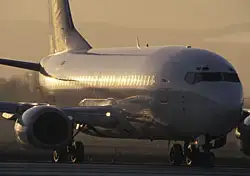
Bankruptcies. Liquidations. Cutbacks. Layoffs. Given the seemingly constant drone of bad news, you’d imagine the beleaguered airlines’ jets were flying empty.
You’d be wrong.
Over this past week, many airlines reported their load factors for May. (Load factor is the percentage of occupied seats. From an economic standpoint, high load factors indicate that demand is strong, a positive for the airlines. From a traveler standpoint, robust load factors are a negative: Full flights mean congestion at boarding and discomfort in flight.)
In May, the major airlines all flew more than 80 percent full. Load factors for the discount carriers and regional airlines were solid as well.
Here are some numbers:
- AirTran flew 79.3 percent full, up from 76.4 percent the previous May.
- Alaska Airlines’ load factor for the month was 77.8 percent, compared to 77.1 percent in May 2007.
- Allegiant Air’s was 89.9%, up from 84.1% the previous year.
- American was flat, at 81.7 percent this year and last.
- Continental’s load factor was off 0.3 percentage points from last May to 81.2 percent.
- Delta flew 82.9 percent full. That’s up from 80.8 percent last year and the airline’s highest May load factor ever.
- Northwest’s load factor rose 1.3 percentage points to 85.6 percent.
- Southwest filled 74.9 percent of its seats, compared with 74 percent last year.
- United was at 82.6 percent this year, down slightly from 84.6 percent in 2007.
By historical standards, the airlines are doing a great job of packing their planes with paying customers. Yet they’re eliminating flights and firing workers.
What’s going on here?
It’s all about pricing power. The airlines are betting that consumers will be willing to pay more if there are fewer available flights. Wall Street agrees.
As reported by MarketWatch, the Amex Airline Index, which tracks airline stocks, rose in response to the latest cuts by [% 2609268 | | United %] and [% 2609480 | | Continental %].
A Standard & Poor’s research note quoted in the MarketWatch story suggests what we can expect over the longer term: “(M)eaningful capacity is starting to come out of the domestic system, which should lead to sharply higher fares in 2009.”
Assuming the capacity cuts are successful in driving prices higher, the move bodes well for shareholders of airlines that survive the current shakeout.
But for travelers, fewer flights will mean even higher load factors and less comfort. So they’ll be paying more, and enjoying it even less. Which suggests a new consumer-focused metric for the airline industry: the misery factor.
We hand-pick everything we recommend and select items through testing and reviews. Some products are sent to us free of charge with no incentive to offer a favorable review. We offer our unbiased opinions and do not accept compensation to review products. All items are in stock and prices are accurate at the time of publication. If you buy something through our links, we may earn a commission.
Related
Top Fares From Columbus, OH
Today's Top Travel Deals
Brought to you by ShermansTravel
Shop and Save with Country Inns...
Patricia Magaña
 Hotel & Lodging Deals
Hotel & Lodging Deals
$229 -- Chicago: Discounted Rates and...
Francesca Miele
 Hotel & Lodging Deals
$229+
Hotel & Lodging Deals
$229+
$188 -- Honolulu: Save on Oceanview...
Abigail Lamay
 Hotel & Lodging Deals
$188+
Hotel & Lodging Deals
$188+



